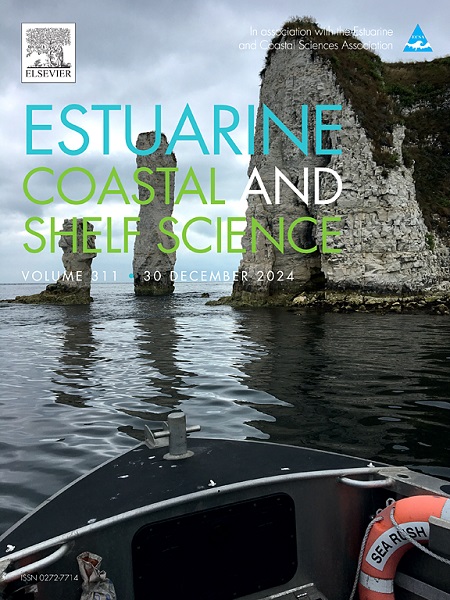Land-sea interactions: Nutrient inputs, fishing effort, and predation shape estuarine fisheries harvest
IF 2.6
3区 地球科学
Q1 MARINE & FRESHWATER BIOLOGY
引用次数: 0
Abstract
Estuarine fish populations, situated at the interface of land and sea, are affected by both land-based and ocean-based anthropogenic activities. Multiple, interactive factors such as nutrient inputs, complex trophic interactions, and fishing pose unique challenges when it comes to the management of estuary fisheries. The objective of our study was to quantify the effects of nutrient inputs, fishing effort, and species interactions on estuary fisheries harvest. Specifically, we developed a food web model that incorporates multiple trophic levels: nutrients, phytoplankton, herbivorous fish (prey), piscivorous fish (predator), with fisheries targeting both fish groups. We parameterized this model using data from Kāneʻohe Bay, an estuary system on Oʻahu, Hawaiʻi. We tested various nutrient regimes in combination with different fishing efforts and predation types (either generalist or specialist). Predation type was a strong driver of both the reciprocal effects between prey fishing and predator harvest, and the degree to which nutrient inputs impacted predator biomass and harvest. Scenarios with generalist predation exhibited less sensitivity to harvest of the other species. Overall, we found that enhanced nutrient inputs can increase fisheries harvest and sustain greater fishing effort, with herbivorous prey species responding more than predators. Our findings highlight the interconnected roles of nutrient enrichment, fishing, and species interactions in driving estuarine system dynamics and fisheries harvest. These complex relationships emphasize the importance of cohesive management strategies that address both top-down and bottom-up drivers to sustain estuarine ecosystems and the important fisheries they support.
陆海相互作用:营养投入、捕鱼努力和捕食决定了河口渔业的收获
位于陆地和海洋交界的河口鱼类种群受到陆地和海洋人为活动的影响。多种相互作用的因素,如营养投入、复杂的营养相互作用和捕鱼,对河口渔业的管理构成了独特的挑战。本研究的目的是量化营养投入、捕捞努力和物种相互作用对河口渔业收获的影响。具体来说,我们开发了一个包含多种营养水平的食物网模型:营养物、浮游植物、草食性鱼类(猎物)、鱼食性鱼类(捕食者),渔业针对这两个鱼类群体。我们使用夏威夷奥胡岛的河口系统Kāne的数据对该模型进行参数化。我们结合不同的捕鱼努力和捕食类型(通用型或专一型)测试了各种营养体系。捕食类型是猎物捕捞和捕食者收获之间相互作用的重要驱动因素,也是养分投入对捕食者生物量和收获的影响程度的重要驱动因素。多面手捕食的情景对其他物种的收获表现出较低的敏感性。总的来说,我们发现增加营养投入可以增加渔业产量并维持更大的捕捞努力,草食性猎物物种的反应比捕食者更大。我们的研究结果强调了营养富集、捕鱼和物种相互作用在驱动河口系统动力学和渔业收获中的相互作用。这些复杂的关系强调了凝聚力管理战略的重要性,这些战略既要解决自上而下的驱动因素,也要解决自下而上的驱动因素,以维持河口生态系统及其所支持的重要渔业。
本文章由计算机程序翻译,如有差异,请以英文原文为准。
求助全文
约1分钟内获得全文
求助全文
来源期刊
CiteScore
5.60
自引率
7.10%
发文量
374
审稿时长
9 months
期刊介绍:
Estuarine, Coastal and Shelf Science is an international multidisciplinary journal devoted to the analysis of saline water phenomena ranging from the outer edge of the continental shelf to the upper limits of the tidal zone. The journal provides a unique forum, unifying the multidisciplinary approaches to the study of the oceanography of estuaries, coastal zones, and continental shelf seas. It features original research papers, review papers and short communications treating such disciplines as zoology, botany, geology, sedimentology, physical oceanography.

 求助内容:
求助内容: 应助结果提醒方式:
应助结果提醒方式:


